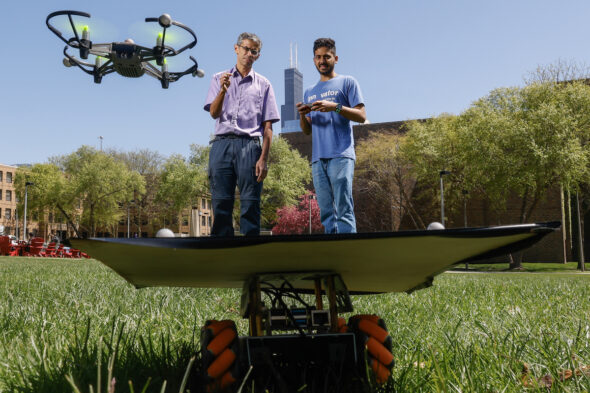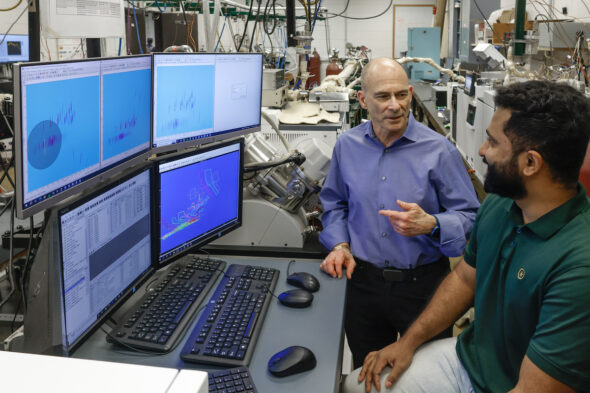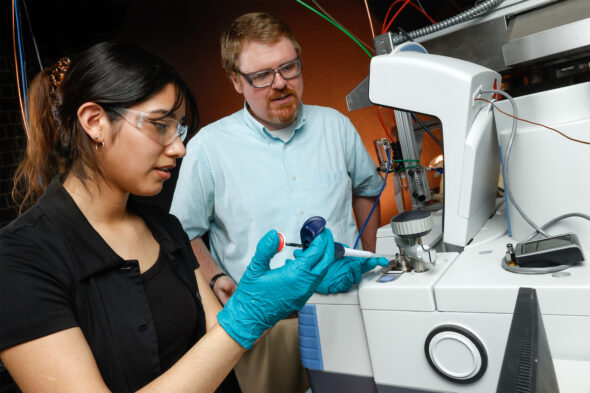UIC researchers advance technologies to power unmanned vehicles

A new $6 million collaborative agreement between the U.S. Army Research Laboratory and engineers from the University of Illinois Chicago will develop fuels and technologies for sustainable aviation and autonomous vehicles.
The funding advances two projects started in 2020 to improve recharging and fuel-sensor technology. In one, UIC researchers Kenneth Brezinsky and Patrick Lynch will adapt a fuel-sensor system they developed to work with an emerging class of sustainable aviation fuels. In a parallel project, Pranav Bhounsule will continue to develop a system that recharges unmanned aerial vehicles in the field without the need for human involvement.
In the future, these innovations could help commercial aviation transition to sustainable fuels and improve the use of drones for package delivery and rescue operations, the scientists said.
“If there is a hurricane and you are trying to search for people in hard-to-access areas, then the best way to do it is probably drones,” Bhounsule said. “And then you could have ground vehicles provide charging, in replication of what we’re doing.”
A flying fuel lab
In the first four years of their project, Brezinsky and Lynch developed new sensors that can detect the properties of fuel, then send signals to a drone’s engine about what adjustments to make.
Unlike cars, drones can run on a wide variety of fuels. Each fuel has a cetane number, similar to the octane number in gasoline fuel. But the cetane number, and the chemistry of a particular fuel used in a drone, can vary dramatically from one fuel to the next. That affects the drone engine’s performance.

“The engine has to be intelligent to adjust to new fuel,” said Brezinsky, professor of mechanical and industrial engineering.
For the first phase of the grant, Brezinsky and Lynch tackled the problem of sensing for these fuels. Using their expertise and advanced facilities for combustion chemistry and spectroscopy, the two designed sensor prototypes that essentially work as mini laboratories in the drone fuel system. Once fuel is added, the sensors scan the liquid to determine its chemical properties.
That data is then analyzed by a computer model trained by machine learning to calculate the cetane number and relay it to the engine’s control center. Then the control center sets parameters to optimally power the vehicle. As testing of the first prototypes is underway, the research team aims to make these components even smaller, at least as small as a coffee cup.
To make their system work with new and emerging aviation fuels, Brezinsky and Lynch will conduct chemical analyses of these fuels and build new computer models that predict their combustion and ignition properties. In some cases, these might be fuels that don’t yet exist.
“We’re trying to rapidly come up with the physical and chemical properties of prospective fuels, even if they’re completely unknown to us,” said Lynch, associate professor of mechanical and industrial engineering. “It shifts the emphasis from sensing to understanding the actual fuel itself.”
Unmanned recharging for unmanned vehicles
Bhounsule is answering a different question: Can drones be recharged in the field without help from humans?
Current electric drones can only fly for 15 to 20 minutes before draining their batteries. Bhounsule, an assistant professor of mechanical and industrial engineering at UIC, has solved this problem by adding a second unmanned vehicle at ground level. As drones fly through an area, small, wheeled vehicles can act as mobile charging stations, traveling where they are needed most.

But the math behind this process quickly gets complicated. Computer models must anticipate when the flying drone’s battery will run out and navigate both the drone and the charging vehicle around obstacles to meet up before the battery dies.
“It turns out that the problem of coordinating these two is not that easy,” Bhounsule said. “And we need to get the solutions in maybe five to 10 minutes.”
Bhounsule’s group has devised and tested in their lab an algorithm that can choreograph this process for up to two flying drones and one charging vehicle. In the project’s second phase, they will expand the system to handle even more vehicles and more challenging terrain.
In addition to the technological innovations, the three researchers highlighted the educational benefits of these projects and the importance of this kind of large-scale collaboration for UIC’s research capabilities.
“Our students are in a fast-paced, goal-oriented research environment, focused on answering questions and delivering on problems,” Brezinsky said. “It gives both students and faculty an opportunity to advance scientific knowledge and enhance the global competitiveness of the United States’ research expertise.”
